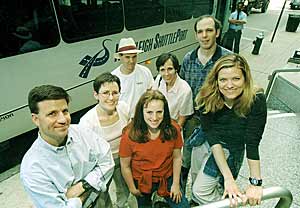


After three months in the hospital, 14-year-old Daniel had completely lost the use of his legs, 45-year-old Harrison could barely move any limb. But thanks to the East Africa Neurosurgery Mission, Daniel is beginning to walk, Harrison can move his hands and legs, and the brain of a 4-year-old girl no longer protrudes through the back of her head.
Neurosurgery in Nairobi
Although the team shortened the hospitals' waiting lists. . .it could make only a small dent in the enormous number of cases. . . .Therefore, education was its main goal.
![]()
THE EAST AFRICA NEUROSURGERY MISSION, organized by Carl Lauryssen, MB, ChB, an assistant professor of neurological surgery, sent a team of St. Louis neurosurgeons and nurses to Nairobi, Kenya, last May. For two weeks, the team treated brain and spinal cord problems at Aga Khan Hospital, Nairobi Hospital and Kenyatta National Hospital, which serve about 40 million people. The St. Louisans also helped educate local nurses and neurosurgeons and transported $400,000 worth of surgical devices donated by American companies. "The entire trip was a total life-altering experience for many of us," Lauryssen says.
Lasting impressions include the hospital staff's devotion
to patients and receptiveness to new knowledge. Camaraderie between the
Americans and their African counterparts also is high on the list. But
there also is the incredible poverty in Kenya, the lack of money for health
care (about $8 per person per year is spent), the difficulty of getting
patients to hospitals or making arrangements by phone, the overwhelming
number of sick people, and the months of waiting in a hospital bed for
an operation so as not to lose a place in line. "On top of that,
if you have a condition like hydrocephalus [fluid on the brain] that requires
a shunt, you have to purchase the device yourself," says Jeffrey
G. Ojemann, MD, an attending surgeon in neurosurgery. "So parents
show up with a shunt in a paper bag."

The neurosurgery team from St. Louis.
Working side by side with the Kenyan surgeons, the St. Louis neurosurgeons operated on 25 cases--babies' heads that were twice the normal size, tumors that preyed on the brain and spinal cord, spina bifida and many other congenital malformations. About 70 percent of the patients were children, like the 4-year-old girl with the occipital encephalocoel. "The back of the brain had not formed normally, and a large part of it extruded from the head," Ojemann says. "The MRI scan showed it was going to be very difficult to close, but we were able to do it."
Spina bifida occurs when the tube that forms the spinal cord fails to snap shut. By the time such babies get to a hospital in Kenya, they usually are several months old, and many die from infection before surgery can be performed. In the United States, spina bifida is much less common and is corrected soon after birth.
Moreover, tumors often grow to an enormous size in Kenya before they can be treated. Michael R. Chicoine, MD, an assistant professor of neurological surgery, helped remove a meningioma (a tumor of the membrane around the brain) so large it had damaged the optic nerve, causing irreversible blindness. Harrison's tumor, which Lauryssen removed, snaked for 3 inches along the upper spinal cord. Daniel already had undergone one operation to remove the tumor in the lower part of his spine. But because of the difficulty of obtaining good radiological images, the Kenyan surgeons had operated at a different level, and the tumor had continued to flourish. "It was a benign tumor, a neurofibroma, but Daniel would have become a quadriplegic and probably would have died if it had not been treated," Lauryssen explains.
Although the team shortened the hospitals' waiting lists by several months, it could make only a small dent in the enormous number of cases waiting for attention. Therefore, education was its main goal. The neurosurgeons taught their counterparts basic neuroanatomy, how to do a neurological exam and how to care for patients after surgery. "The physicians had received good training, but there were some things they had not been exposed to," Ojemann says.
The nurses taught classes and workshops, handed out literature and trained their counterparts to look after patients in Kenyatta National HospitalŐs new intensive care unit. "Nurses get associate degrees, but there is no continuing education, no training in neurosurgery and no reference books on the floor," says Dawn Schuessler, nurse coordinator in neurosurgery.
Part way through the mission, Chicoine had to return to the United States because his father died. As a tribute, the team purchased chairs for the neurosurgery floor so patients can spend time out of bed.
The six neurosurgeons, anesthetist, four nurses and Kathleen Kumanomido, the medical secretary who monitored every last detail, paid their own fares and used up personal vacation time. Washington University School of Medicine, DePuy Acromed and Synthes Spine helped finance the trip, and the Kenyan government subsidized the accommodations.
The team hopes to return to Nairobi every year and to bring Kenyan nurses and surgeons to the United States. "We want to share the recent, rapid developments in neurosurgery with the highly trained, highly educated surgeons in Kenya," Ojemann says.
Lauryssen also wants to share simpler advances in medical care. "If we could provide folic acid to Kenyan women of childbearing age, we could decrease the number of pediatric neurosurgeries by about 70 percent because spina bifida results from lack of this vitamin," he says. "We therefore would like to find funding for a public health program."
Back in St. Louis, the team is appreciating the many things they used to take for granted--sterile techniques, machines that work, unlimited supplies of aneurysm clips, and only one patient per bed. "We can become blind to the luxuries we have," Schuessler says. "But the trip to Kenya was an eye-opener. I am so grateful for the care we can offer in St. Louis."